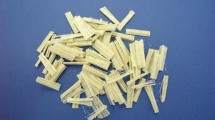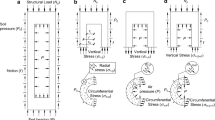Abstract
Energy pile is a ground source heat pump technology that couples foundation pile with ground heat exchangers for geothermal energy exploitation. However, the thermally induced contraction and expansion of the concrete affect the heat transfer performance and sustainable operation of the energy piles. In order to minimize these effects, a set of concrete samples was tested by deploying heating-recovery-cooling-recovery cycle. Three different concrete samples including plain concrete, polypropylene reinforced and steel fiber reinforced concretes are prepared. Temperature and stain development of the concrete samples were continuously recorded during the testing process. The results show that heating expansion and cooling contraction are both reduced for steel fiber reinforced concrete. For polypropylene fiber reinforced concretes, only the heating expansion is reduced but the contraction is larger than the plain concrete. Finally, the content of steel fiber of 1.3% is optimized to minimize the thermally induced mechanical effects on steel fiber reinforced concrete for energy piles.
Access provided by CONRICYT-eBooks. Download conference paper PDF
Similar content being viewed by others
Keywords
1 Introduction
The energy pile is a renewable geothermal energy coupled pile foundations as ground heat exchangers [1]. Compering with the traditional borehole heat exchangers, the energy piles are known to be cost economically. Energy piles put heat exchanges into the foundations and save the cost of drilling and area to install borehole. Pahud put the u-type heat exchanger into the concrete piles and applied the concrete piles as foundation of Munich airport building [2]. Since 21 century, energy piles installed widely in the developed countries and were being an important research topic [3,4,5]. It was the first time that energy piles were used in Tianjin China in 2004.
With reference of experiences on projects at home and abroad, the operating of energy piles is a complicated thermal-mechanical process. the expansion and shrinkage of the plies material affects long-term running and the safety of buildings due to energy piles operate in cooling and heating thermal load for different seasons, Laloui tested the energy piles in the Swiss federal Institute of Technology in Lausanne, the length of energy piles was set for 15 m, the diameter was set for 117 cm, when temperature difference between the energy piles and ground approached to 15 °C, additional temperature stress was measured to be 2 MPa and the deformation on the top of piles was 4 mm [6]. P Bourne-Webb, BL Amatya researched the energy piles at the Lambeth Academy in London, the length and diameter of energy were set to 23 m and 55 cm, when energy piles heated to 28 °C, thermal load was measured to 500 kN, what’s more, the expansion of energy piles was about 2 mm [7, 8]. AD Donna developed a 3-dimensional finite model and simulated the deformation of energy piles after seasonal thermal storage operation, the energy piles heated to 40 °C, the expansion was 4 mm [9].
In conclusion, additional temperature stress affects long-term running and the safety of buildings during seasonal thermal storage operation [10, 11]. To deal with problem above, this paper aims to investigate thermal-mechanical behavior of grouting concretes, polypropylene and steel fiber reinforced concretes in energy piles, and find the optimal proportion of energy piles.
2 Material and Test Program
2.1 Materials
Samples are made by ordinary Portland cement, the maximum size of coarse aggregate size is about 5 mm. the length of steel fiber is 10 mm, cross sectional area is measured to be 1 mm × 0.8 mm, respectively, the length of polypropylene is 8 mm. Concrete mix proportion listed in Table 1 is obtained by The Design Regulations Of Mix Ratio Of Ordinary Concrete (JGJ55-2011), the sample is Cylindrical and the diameter and height of sample are 50 mm and 100 mm, respectively. According to thermal conductivity experiment, the maximum thermal conductivity is measured to be 2.44 \( {\text{W/m}} \cdot {\text{K}} \) in the concrete with content of the steel fiber of 1.3%, the optimal content of steel fiber and polypropylene is set to be 1.3% and 0.7% respectively. All samples named C1 C2 C3.
2.2 Test Program
To investigate the thermal-mechanical characteristics of reinforced grouting concretes in energy piles. As shown in Figs. 1, 2, 3 and 4, we have developed 815 rock mechanic test system, heating panel, cooling system. The test steps divide into heating, recovery, cooling, recovery stages and simulate energy piles operation during seasonal thermal storage. The samples were set into MTS system with the heating panel, the MTS system provided the axial stress 28 kN and kept stable for 20 min, firstly, in the heating stage, the heating panel was set to 55 °C, and kept stable for 30 min. Then, stopped heating and recovered to the indoor temperature for 60 min, cooling system kept the temperature to 0 °C at next cooling stage. Finally, recovered to the indoor temperature for 60 min. In terms of monitor, MTS system kept the axial stress stable and stored the stain of each samples per second throughout the experiment, meanwhile. The stain of samples developed with time was obtained.
3 Results
As shown in Fig. 5, comparing with the plain concrete C3, steel fiber reinforced concrete samples C1 reduced the strain of the heating expansion and cooling shrinkage, and polypropylene fiber reinforced concrete samples C2 reduced the strain of the heating expansion but increased the strain of cooling shrinkage. Respectively, that means steel fiber added into plain concrete can improve the both compressive strength and tensile strength of concrete, however, polypropylene fiber added into plain concrete can only increase the tensile strength but reduce the compressive strength of concrete.
Table 2 shows that strain of the both steel fiber and polypropylene fiber reinforced concrete was reduced by adapting heating loads, comparing with plain concrete C3, steel fiber reinforced concrete sample C1 reduced about 49.6% and polypropylene fiber reinforced concrete sample C2 reduced about 38.1% in heating stage, meanwhile, in the cooling stage, the strain of steel fiber reinforced concrete sample C1 was reduced about 28.8% but polypropylene fiber reinforced concrete sample C2 increased about 81.9%.
4 Conclusions
The results show that the maximum thermal conductivity is measured to be 2.44 \( {\text{W/m}} \cdot {\text{K}} \) in the concrete with content of the steel fiber of 1.3%. The strain of the both steel fiber and polypropylene fiber reinforced concrete is reduced by adapting heating loads, steel fiber reinforced concrete reduces about 49.6% and polypropylene fiber reinforced concrete reduces about 38.1%. Furthermore, heating expansion and cooling shrinkage strain are both reduced for steel fiber reinforced concrete during the heating and cooling load cycles testing, but polypropylene fiber reinforced concretes increase cooling shrinkage strain. Comparison of the three different pile concretes, steel fiber reinforced concrete is suggested to be a suitable material for the grouting of energy piles and the optimal proportion of steel fiber is 1.3%.
References
Hamada, Y., Saitoh, H., Nakamura, M.: Field performance of an energy pile system for space heating. Energy Build. 39, 517 (2007)
Pahud, D., Fromentin, A., Hadorn, J.C.: The Duct Ground Heat Storage Model (DST) for TRNSYS Used for the Simulation of Heat Exchanger Piles. User Manual, December 1996 Version (1996)
Sekine, K., Ooka, R., Hwang, S., Nam, Y., Shiba, Y., Eng, M.: Development of a ground-source heat pump system with ground heat exchanger utilizing the cast-in-place concrete pile foundations of buildings. ASHRAE Trans. 113, 558–566 (2007)
Shiba, Y., Ooka, R., Sekine, K.: Development of a high-performance water-to-water heat pump for ground-source application. ASHRAE Trans. 113, 261–270 (2007)
Omer, A.M.: Ground-source heat pumps systems and applications. Renew. Sustain. Energy Rev. 12, 344 (2008)
Laloui, L., Nuth, M., Vulliet, L.: Experimental and numerical investigations of the behaviour of a heat exchanger pile. Int. J. Numer. Anal. Methods Geomech. 30, 763 (2006)
Bourne-Webb, P., Amatya, B., Soga, K., Amis, T., Davidson, C., Payne, P.: Energy pile test at Lambeth College, London: geotechnical and thermodynamic aspects of pile response to heat cycles. Géotechnique 59, 237 (2009)
Amatya, B.L., Soga, K., Bourne-Webb, P.J., Amis, T., Laloui, L.: Thermo-mechanical behaviour of energy piles. Géotechnique 62, 503 (2012)
Donna, A.D., Loria, A.F.R., Laloui, L.: Numerical study of the response of a group of energy piles under different combinations of thermo-mechanical loads. Comput. Geotech. 72, 126 (2015)
Loria, A.F.R., Gunawan, A., Shi, C., Laloui, L., Ng, C.W.W.: Numerical modelling of energy piles in saturated sand subjected to thermo-mechanical loads. Geomech. Energy Environ. 1, 1 (2015)
Jin, L., Rohn, J., Wei, X., Bertermann, D., Blum, P.: A review of ground investigations for ground source heat pump (GSHP) systems. Energy Build. 117, 160 (2016)
Author information
Authors and Affiliations
Corresponding author
Editor information
Editors and Affiliations
Rights and permissions
Copyright information
© 2018 Springer Nature Switzerland AG
About this paper
Cite this paper
Huang, W., Xiang, W., Luo, J. (2018). Thermo-Mechanical Behavior of Reinforced Concretes for Energy Piles. In: Wu, W., Yu, HS. (eds) Proceedings of China-Europe Conference on Geotechnical Engineering. Springer Series in Geomechanics and Geoengineering. Springer, Cham. https://doi.org/10.1007/978-3-319-97115-5_152
Download citation
DOI: https://doi.org/10.1007/978-3-319-97115-5_152
Published:
Publisher Name: Springer, Cham
Print ISBN: 978-3-319-97114-8
Online ISBN: 978-3-319-97115-5
eBook Packages: EngineeringEngineering (R0)









